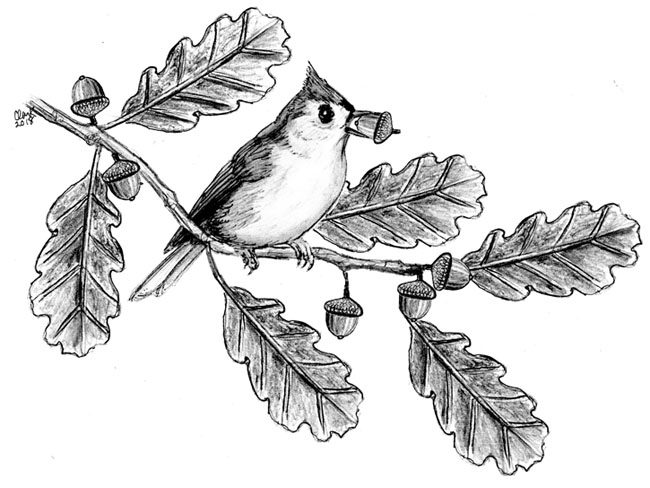
Dear Bird Folks,
I’m wondering if you could write a column about the Tufted Titmouse. It’s one of my favorite birds, yet I think it’s often ignored and under appreciated.
– Pat, Sandwich, MA
You bet I will, Pat,
It’s the holiday season, so if I’m ever going to be cooperative and obliging, now is the time. Besides, I agree with you. The Tufted Titmouse, one of our most common feeder birds, is indeed unappreciated. I think the problem is its name. It sounds kind of wimpy. Other birds, such as ravens, hawks and falcons convey such powerful images we have named sports franchises after them. But have you ever heard of a team called the, “Fighting Titmice”? I don’t think so. Plus, I think the name titmouse makes folks uncomfortable. People simply don’t like mice of any kind. (Although I know quite a few people who really like…hmm, never mind.)
If you live in Massachusetts and are a fan of Tufted Titmice (the bird, not the team that doesn’t exist), you are living in prime time. Back in 1959, long before I was born, there was a grand total of four lowly titmice reported in that year’s Christmas bird count. That’s all. Why so few? Historically, titmice are a southern species, but that all changed in the 1960s when the birds began expanding northward, into our area. The reasons for their sudden interest in Massachusetts aren’t totally clear, but it likely has to do with milder winters, an abundance of bird feeders and, of course, the Kennedys. Today, titmice are ubiquitous in Massachusetts, found in every town except one. Wanna guess which town is titmouse-less? I’ll tell you at the end. (No fair reading ahead. If you do, you’ll miss all the exciting titmouse talk and you wouldn’t want to do that…I hope.)
There are five species of titmice in North America and ironically, they all have tufts on their heads. But fortunately for us, ours was able to grab the “tufted” name first. A few Western states have Oak or Juniper Titmice. These two birds are so bland and innocuous, they were once considered to be the same species, appropriately named Plain Titmouse…with the emphasis on “plain.” Arizona, however, has a really distinctive species, the Bridled Titmouse and I’m a little jealous. This is a cool looking bird. It has a black chin and thin black lines running along the sides of its face, reminding me of one of those designer beards David Ortiz sometimes has. (Yup, Big Papi has a face like a titmouse…but I’m not going to be the one to tell him.)
What our Tufted Titmice lack in clever face patterns, they make up for in vocalization. Each spring these birds sing loud and incessantly. Their classic song is a rowdy whistle that sounds like “peter, peter, peter.” But there is so much more. Famed field guide author, David Sibley, writes that the Tufted Titmouse songs are varied and “under-appreciated.” (See, even Sibley agrees with us.) Whenever I hear a call I can’t identify, it invariably turns out to be a titmouse. In the beginning I would be disappointed, hoping it was coming from a less common bird. Now I just smile and think, “It got me again.” Learning the entire assortment of titmouse songs is a difficult thing to do. Beginners should just concentrate on knowing the signature “peter, peter, peter” song, which is always fun to hear…unless your name happens to be Peter.
I recently wrote how titmice love to come for peanuts, especially peanuts that are still in the shells. It’s surprising to see such a small bird carrying such a large nut, but they wouldn’t want it any other way. These birds aren’t into tiny nibbles. Believe it or not, one of their favorite foods is acorns. Yes, acorns, those rock hard things even squirrels have trouble chewing, is the titmouse’s cuisine of choice. Somehow the birds are able to grasp them with their stubby beaks, carry them off to a quiet perch and hammer them open. Any leftovers are cached for later. Titmice are notorious for gathering extra food in the fall and stashing it away for a rainy day, or more accurately, a snowy day.
Here is something else folks don’t seem to know about titmice: they readily build their nests in birdhouses. I’m routinely asked about houses for bluebirds, wrens, Purple Martins and even owls, but in thirty-five years no one has ever asked for a titmouse house. And titmice don’t require anything fancy or special, like owls or martins do. A simple box, with a 1-5/8th” opening is all they want. Well, a box and maybe a little fur, too. Female titmice love to line their nests with fur. They will use all sorts of animal fur and even human hair. Once a customer sent me a great video of a titmouse plucking strands of hair off his head. I laughed and thought, “better him than me.” These days, I need to hang on to all the hair I have.
You are right, Pat. Tufted Titmice are under-appreciated and I don’t get it. They are friendly birds with imaginative singing. They also come to our feeders and birdhouses, and will even trim our hair. But there is one thing they won’t do. They won’t fly over water. Really. Thus, Nantucket (as far as I know) is still the only town in Massachusetts without titmice. This means the residents on Nantucket don’t get to see this charming bird, don’t get to hear its raucous song and worst of all, they have to cut their own hair.